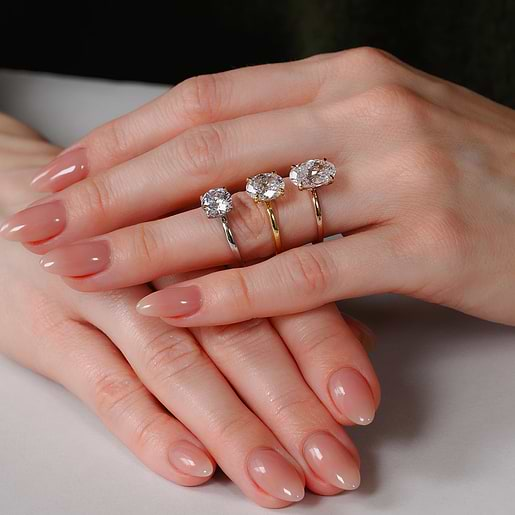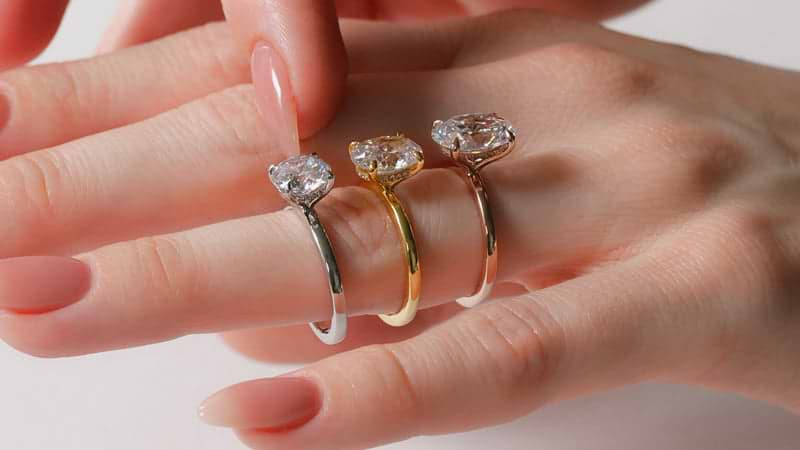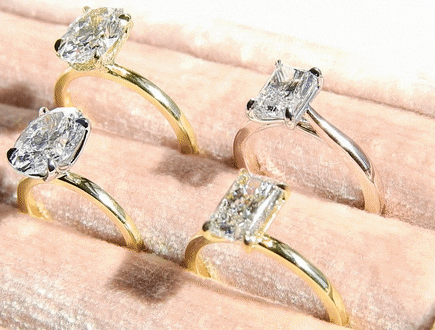What Metal is Best for an Engagement Ring?

Selecting the best metal for your engagement ring goes beyond personal preference for either yellow or white gold. When you're custom designing one of the most important pieces of jewelry you'll ever own, you'll want to consider your choice of ring metals very carefully.
Ring Metal Types: What’s the Difference?
There are a variety of engagement ring metals from which to choose. Its important to understand the difference between ring metal types, the advantages and disadvantages of each and which will work best for your engagement ring.
18k Yellow Gold
Advantages
An 18k yellow gold engagement ring is going to be brighter with a richer color than a 14k yellow gold ring. And because it contains less alloy (75% gold/25% alloy as compared with 58.5% gold/41.5% alloy in 14k yellow gold) its going to be less likely to cause any kind of allergic reaction. You'll find that diamonds complement the elegant golden hue of 18k yellow gold, and there's a nice contrast between colorless diamonds and yellow gold that makes small accent diamonds pop.
Disadvantages
One of the few disadvantages of 18k yellow gold is that its costlier than 14k gold because it contains more pure gold. However, its important to bear in mind that you're creating an engagement ring that's meant to last a lifetime, so choosing this ring metal type is a wise investment.
Another potential drawback to keep in mind is that center diamonds set in 18k yellow gold will reflect some of the yellow hue. This can give even colorless diamonds a warmer look. To avoid this, consider setting your center diamond in platinum prongs, which will keep it looking bright and white.
18k White Gold
Advantages
An 18k white gold engagement ring can be dazzling as well. With the same karatages and purity as 18k yellow gold and then plated in pure rhodium, you'll likely not experience an allergic reaction to this ring metal type. 18k white gold is a popular engagement ring metal for people who are drawn to wearing cool colors. Mixed with white metal alloy, white gold is slightly stronger and scratches less easily than yellow gold. Additionally, with its similar in appearance to platinum, it's a more affordable alternative. Finally, white gold reflects and enhances the sparkle of diamonds.
Disadvantages
In order to retain its color and luster, 18k white gold will require "dipping" every few years to replace its rhodium plating. However, the process is free with our lifetime maintenance and well worth the results you'll see.
14k Rose Gold
Advantages
because of its pinkish hue, a rose gold engagement ring is considered the most romantic-looking type of engagement ring. It has a soft shade that complements many skin tones. Mixed with copper alloy to create its distinctive color, 14k rose gold contains less pure gold than higher karats, which can bring down the price slightly. The copper alloy also tends to make 14k rose gold more scratch-resistant than other ring metal types.
Disadvantages
Unfortunately, 14k rose gold is not hypoallergenic and it can cause an allergic reaction for some. Its also not as highly available as other ring metal types despite it being in style.
Platinum
Advantages
Platinum is 95% pure, is more durable than gold and is the strongest metal for rings. It offers the same shiny appearance as white gold, making it one of the best metals for an engagement ring. Because of the purity of its alloys, platinum engagement rings won't fade, corrode or tarnish over time. Platinum engagement rings require very little maintenance and are hypoallergenic making this ring metal type a good choice for those with sensitivities. Finally, diamonds display brilliantly in a platinum engagement ring setting.
Disadvantages
Platinum is the rarest precious metal making it costlier than other ring metal types. Its also a dense metal making it about 35% heavier than yellow gold which many people actually love! It can be a nice feeling to have a good weight to your ring.

Two Tone Yellow Gold and Platinum
Advantages
An 18k yellow gold engagement ring with a platinum center setting will offset your white diamond and make it sparkle even more. And because the ring metal type is so durable, your precious diamond will be more secure in a platinum setting. A two-tone 18k yellow gold and platinum ring is less likely to cause an allergic reaction. An engagement ring in a two-tone setting gives the jewelry a more unique appearance than a single colored ring metal type.
Disadvantages
The combination of these two precious engagement ring metals will increase the price of an engagement ring; additional design, casting, and labor charges are involved. However, with its lovely appearance, long-lasting durability and distinctiveness, its well worth the investment.
Two Rose Gold and Platinum
Advantages
Combining the romantic beauty of 14k rose gold with the strength and shine of platinum, makes these two-tone engagement rings an enchanting reflection of your love. A white diamond sparkles even more in the platinum prong setting while rose gold is flattering to every skin type. This type of engagement ring is exceptionally striking and unique.
Disadvantages
As previously mentioned, people with skin sensitivities may suffer an allergic reaction to a rose gold band. However if your heart is set on rose gold and youre not sure if youll react to its alloys, you can try wearing a simple 14k rose gold band before investing in and designing a costlier diamond engagement ring.

What Type of Engagement Ring Metal Type Will You Choose?
Beyond the properties of the individual ring metal types themselves, there are other factors to consider when choosing your engagement ring metal type:
Gemstone. You'll want to consider how well the ring metal style complements your chosen gemstone. Sparking lab grown, ethically sourced diamonds look stunning in a variety of ring metal types.
Ring design. A rings design can influence the type of ring metal you select. For example, a vintage looking design may look lovelier in two-tone rose gold and platinum as opposed to white gold alone.
Setting. The setting can offset your gemstone and increase its sparkling appearance. A shining platinum setting can really make your lab grown diamond pop.
Personal preferences. You may have a strong preference for a specific color of metal. Perhaps all your jewelry is yellow gold and you want your engagement ring to be the same.
Durability. Different ring metals have different levels of durability. Some are more resistant to scratches than others. Consider your lifestyle and daily activities to determine which type of engagement ring metal is right for you.
Color. Choose a color that complements not only your gemstone but your skin tone as well.
Maintenance. Different metals require different levels of maintenance and care. Some may be more prone to tarnishing and scratching than others. Determine how much time and money you want to put into caring for your ring.
Budget. Your budget is another factor to think about when choosing your ring metal. Some come with a higher price point than others but you may feel that they're worth it to have the ring you've always dreamed of.
What is the Best Metal for an Engagement Ring?
Of course, the best metal for your engagement ring is the one you choose. Creating a one-of-a-kind engagement ring is an exciting and very personal process. We recommend browsing through our collection of lab grown engagement rings to discover a style that you'll love for years to come.











